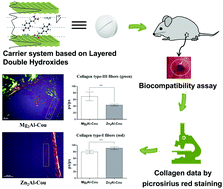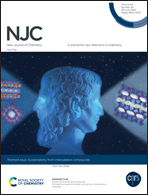Phytochemical species intercalated into layered double hydroxides: structural investigation and biocompatibility assays†
Abstract
The compound p-coumaric acid (HCou) is found in many foods and presents action in the suppression of chronic diseases and protective effects on neurodegenerative disorders. This work presents the intercalation of this phytochemical species into Layered Double Hydroxides (LDHs) of magnesium–aluminum and zinc–aluminum using a coprecipitation method. Solid samples were characterized by X-ray diffraction, solid-state 13C Nuclear Magnetic Resonance, mass coupled thermal analysis, and vibrational spectroscopy. The amount of coumarate anions in the LDH-Cou materials is about 32–35 wt%. Better crystallinity was observed for Zn2Al-LDH compared to Mg2Al-LDH attributed to a better stacking of the layers. According to XRD data and the one-dimensional (1D) electron density map, the coumarate anions in Zn2Al-LDH are accommodated in a bilayer arrangement with the aromatic ring perpendicular to the layers and the carboxylate groups interacting with the hydroxide layers. The thermogravimetric analysis coupled to mass spectrometry showed an increased thermal stability and distinct decomposition profiles of the intercalated organic species compared to the sodium coumarate salts. Interestingly, solid-state 13C NMR spectra combined with elemental and thermal analysis strongly suggest the presence of two intercalated structures in the case of the Mg2Al carrier with particles containing either the monoanion (Cou−) or the dianion (Cou2−) while Zn2Al intercalates only the monovalent coumarate anion. Biocompatibility of LDH-Cou materials was assessed by in vivo assays via tablet implantation in the rat abdominal wall. After 28 days of implantation, completing the tissue remodeling process, the healing response is positive (lack of antigenic reaction signals around both tablets), indicating a state of biointegration and biocompatibility. Also, the LDH tablets were found to promote collagen deposition without the presence of fibrotic encapsulation. These data open new opportunities for the application of LDHs intercalated with bioactive species in implantable devices.

- This article is part of the themed collection: Sustainability from intercalation compounds


 Please wait while we load your content...
Please wait while we load your content...